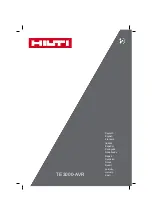
2-8
BOP HIPWR 091719
3. Connect a digital voltmeter (DVM) (resolution and accuracy of 0.01% or better) to the
OUTPS and COMS terminals at the rear panel terminal block.
4. Use the keypad to enter the rated maximum voltage of the power supply (e.g., enter 36 for a
model BOP 36-28MG) and press
ENTER
. If STANDBY indicator is lit, press
STANDBY
key.
5. Verify DVM voltage reading agrees with programmed voltage within 0.03% of rated maxi-
mum voltage and agrees with displayed voltage on LCD within 0.05% of rated maximum
voltage.
2.4
INSTALLATION
2.4.1
RACK MOUNTING
The unit is shipped with four feet attached to bottom of the unit which must be removed prior to
installation (see Figure 1-2). The BOP is designed to be rack mounted in a standard 19-inch
wide rack using the mounting ears (supplied) attached to the front panel (see Figure 1-2). Allow
a minimum of 7/8 in. (22.2 mm) above and below the unit to permit air intake necessary for
proper cooling of the unit.
CAUTION: The rack must provide support at the rear (within 6
inches of the rear panel). Optional slides can also be used (see PAR. 2.4.2).
2.4.2
SLIDE INSTALLATION
Optional slides are available for rack mounting (see Table 1-4 and Figure 1-2).
2.5
WIRING INSTRUCTIONS
Interconnections between an a-c power source and a power supply, and between the power
supply and its load are as critical as the interface between other types of electronic equipment.
If optimum performance is expected, certain rules for the interconnection of source, power sup-
ply and load must be observed by the user. These rules are described in detail in the following
paragraphs.
CAUTION: When working with active loads, the voltage or current of the active load
must not exceed the maximum voltage or current rating of the BOP. Other-
wise the overvoltage or overcurrent protection will shut down the power sup-
ply.
2.5.1
SAFETY GROUNDING
Local, national and international safety rules dictate the grounding of the metal cover and case
of any instrument connected to the a-c power source, when such grounding is an intrinsic part of
the safety aspect of the instrument. The ground terminal of the source power connector (Figure
2-1) is connected to the chassis and the instructions below suggest wiring methods which com-
ply with these safety requirements; however, in the event that the specific installation for the
power system is different from the recommended wiring, it is the customer's responsibility to
ensure that all applicable electric codes for safety grounding requirements are met. As a pre-
caution, always connect the stud marked
at the rear panel to proper earth ground.
2.5.2
SOURCE POWER CONNECTIONS
Source power is connected to the power supply via three-wire input power using the source
power mating connector supplied (see Table 1-3). See Table 1-2 for source power specifica-
tions. This power supply operates from single phase a-c mains power (or between two phases
Содержание BOP-ME 1KW
Страница 2: ......
Страница 20: ...xii BOP 1K 091719 FIGURE 1 1 HIGH POWER BOP SERIES POWER SUPPLY...
Страница 42: ......
Страница 64: ...2 22 BOP HIPWR 091719 FIGURE 2 11 PARALLEL CONFIGURATION LOCAL SENSING TYPICAL...
Страница 65: ...BOP HIPWR 091719 2 23 FIGURE 2 12 PARALLEL CONFIGURATION REMOTE SENSING TYPICAL...
Страница 76: ......
Страница 161: ...BOP HIPWR 091719 3 85 FIGURE 3 29 STATUS REPORTING STRUCTURE...
Страница 164: ......
















































